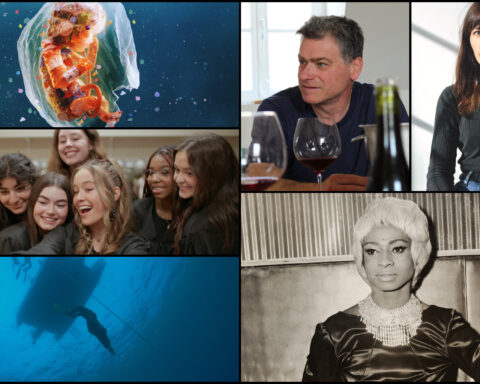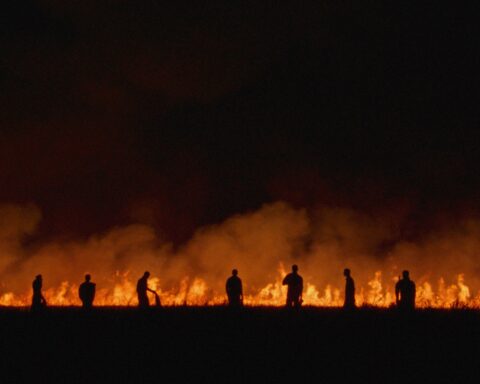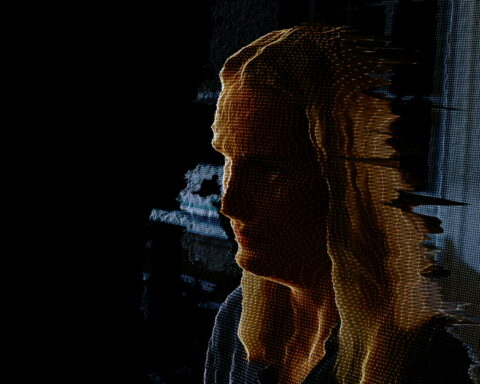The documentation of landscape by photographers is as alluring today as it was at the beginnings of photography, perhaps because the genre offers a comforting niche for soul-searching and exploration of one’s time and place. Focusing a camera on a landscape can be a metaphorical way of focusing a lens on yourself, as three photographers exhibiting at Harbourfront Centre during the Scotiabank CONTACT Festival — Johan Hallberg-Campbell, Joanne Ratajczak and Morris Lum — have demonstrated, albeit each in a decidedly different way. The three artists, who were all born outside Canada, set out to explore their new country as a way of coming to terms with it. Their installations are part of the clamour around the 150th anniversary of Confederation.
In Coastal, Hallberg-Campbell (b. Scotland) has answered the call of the land—that enduring dynamic of Canadian art—by travelling to the far reaches of Canada’s three coastlines to explore “what it means to belong to a rapidly diminishing community with traditions entrenched in heritage.” Co-curator Patrick Macauley’s statement—that by uncovering “the layers of daily life alongside vast oceans” he reveals “what remains but what also is no longer there”—rings unequivocally true. One of the more mysterious powers of photography is to impart a better understanding of the notion of presence, absence and ensuing traces. Hailing from a small coastal town of Scotland, Hallberg-Campbell has a penchant for finding ordinary objects in small communities that reveal far more than what is recorded by the camera.
His photograph, Flatrock, Newfoundland, 2011 depicts an old fishing boat propped on land in the stillness of dusk, fully lit by a street lamp. It is partially covered by a plastic tarp, and very little of the boat’s deep-sea blue paint has survived the ravages of sea, salt and time, clearly revealing the sturdy original wood boards. In a Newfoundland context, such a boat is not uncommon. But Hallberg-Campbell has depicted this remnant of the past in a predictably romanticised way by shrouding it with the evanescent light of a clear blue sky that occurs only in the brief moments between dusk and deep night. What is important is not what the picture is purportedly about on the surface: it represents an elegiac lament to a remnant of history, a “time that was.” This becomes suddenly clear when we finally focus on a little sign tacked to the side of the boat that says “for sale.” It’s as if through these two words, the tragic end of the traditional fishing industry of Newfoundland has been revealed; the “for sale” sign symbolises a chapter of a community’s history.
The show continues in this vein in an installation of large-scale photographs, some of which are floor-to-ceiling images outputted on vinyl. Harrington Harbour, Quebec, 2013 is a simplistic picture, not unlike an ordinary snapshot, of a bright pink fishing hut that has been toppled on the lichen-covered rocky outcrop, like a piece of debris strewn by the wind. When we see the sad-looking hut, we think of the laughter, anticipation and the passage of time that has taken place in this modest structure. Later, in a photograph of a fleeting kiss by a couple, in the barren landscape of Havre–Saint-Pierre, we can easily imagine the improbabilities of a moment of tenderness in an otherwise lifeless environment. In the almost indiscernible remnants of a loggers’ cabin from the 1900s that is slowly being reclaimed by the lush undergrowth of the forests of Haida Gwaii, we find ourselves approving of the naturalness of the evolutionary process as things are slowly re-absorbed into the earth.
Hallberg-Campbell’s self-indulgence is apparent in his body of work, and the banality of the “thing” depicted relies wholly on the willingness of the viewer to elevate it to a different realm. Does the personal vision of the artist become a shared collective experience? It is a question worth pondering as you walk through this installation.
In contrast, Polish-born Joanne Ratajczak’s exhibition, Yukon Sketchbooks, is not about traces of civilisation on the landscape but, as she writes, the experience of a wayfaring artist, “a wanderer…who sets out on a journey with no real plan. ” Three years ago, the Toronto-based photographer set out with her car to photograph the “end of roads, and she eventually found herself in the Yukon.” Ostensibly, it was a journey in search of her inner self, and the resulting work—eight vitrines of photographs, sketches and working journals—are part of a larger, on-going series. It is her interaction with the environment, perhaps on the road “less travelled” that fascinates the artist. As she says, this body of work is a “case study of how an environment can lead an artist to a theme that mirrors the artistic journey: driving north and away but finding answers to the here and now.”
In one of her most memorable pieces, Ratajczak has made a lush study of the Mac Pass, in the Mackenzie Mountain Range, a foreboding valley that is all but impassable. At first it appears to be another lonesome landscape of bare slopes with a few patches of scraggly spruce trees and swaths of bright pink flowers that punctuate the grey and blue mountain faces. It is anything but that. Ratajczak has ably interpreted this vast place as if it were a giant canvas, where a painting has been in process for centuries, with the brush strokes of colour changing with each passing day of vegetative growth. The mountains are symmetrically balanced in her composition, with the entrance of the valley opened to us to partake of the site. As viewers, we find ourselves standing at the welcoming door of a sacred place. It is impossible for us—as it would be for the visitors to the actual mountain pass—not to be moved emotionally and feel the duality of the fragility and resilience of the place. Ratajczak gives us a canvas of a primeval locale where you can almost hear the silence of centuries, and, like the artist, we also feel “at home.” Her journey of self-discovery is rendered even more convincing by the intimate notes and journal entries that she shares as part of her creative process.
Morris Lum (b. Trinidad and Tobago, with roots in Hong Kong and Macau) takes us on a different voyage altogether, on the land transformed by Chinese settlements in cities across Canada. In his ongoing series The Chinese Canadian Railway, the Mississauga-based artist has embarked on an exhaustive exploration of “clusters of communities that over time have built Chinatowns” in nine cities across Canada, from coast to coast. Using a large-format camera, his objective is to produce visual records of cityscapes by focusing on cultural fixtures such as small mom-and-pop shops, Chinese restaurants and community organisations, with a view to document “the memory and explore the future of the Chinese community in Canada.”
As part of this multi-year project, Lum’s Tong Yan Gaai (Cantonese for Chinatown), exhibited at Harbourfront Centre, specifically looks at the challenges faced by many historical Chinatowns as redevelopment pressures threaten their survival. It includes exterior and interior views of historically significant buildings in Vancouver that are succumbing to condominium and gentrification pressures.
His two photographs of the ornate interior of the Chin Wing Chun Society Building on Pender Street in the heart of Chinatown are beautifully crafted in a classic documentary style that conveys the spirit of the 1920s, when such houses were built to assist Chinese families upon arrival in Canada. Such houses were usually the first point of contact for many Chinese immigrants, and it is fitting that a photographer of that heritage has been making statements in the artistic community through this project. Although the project is about the documentation of heritage properties, it is also about the artist coming to terms with his own heritage, part of the broad sweep of the immigrant experience.
Both photographs in Chin Wing Chun, 2014 are displayed outdoors, mounted large, above the east and west entrances of Harbourfront Centre. Despite the laudable intention of making the work more accessible to a general public, the exterior installation comes across as too casual. High above the door, each photograph is too easy to miss, almost like another ubiquitous billboard. The richness of detail, the lush colour and the textures will be lost to many, as is their concomitant introspection.
The installation of Lao Tsu Mural, 2013, a floor-to-ceiling photograph produced on vinyl and affixed directly onto the wall inside the Photography Gallery that also functions as a public walkway, is far more successful. The mural was created in 2010, on the side of a building in a parking lot, in order to commemorate the 125th anniversary of Vancouver’s Chinatown, and depicts Lao Tsu, the Chinese philosopher from the Zhou Dynasty (6th–4th centuries B.C.), riding an ox against the backdrop of cloud-piercing mountains and a flock of Canada geese in flight. The idyllic scene quickly became an iconic landmark in the community, but soon enough it was hidden from sight by the construction of a new building. With this and other works, Morris Lum is well on his way to creating a valuable documentary project in a community whose architectural heritage has been largely overlooked.
As if by serendipity, the Lao Tsu Mural includes a quotation from the revered philosopher that would seem to summarise the quest and journeys not only of Morris Lum, but also Johan Hallberg- Campbell and Joanne Ratajczak: “It takes knowledge to understand others, but it needs a clear mind to know oneself.”











